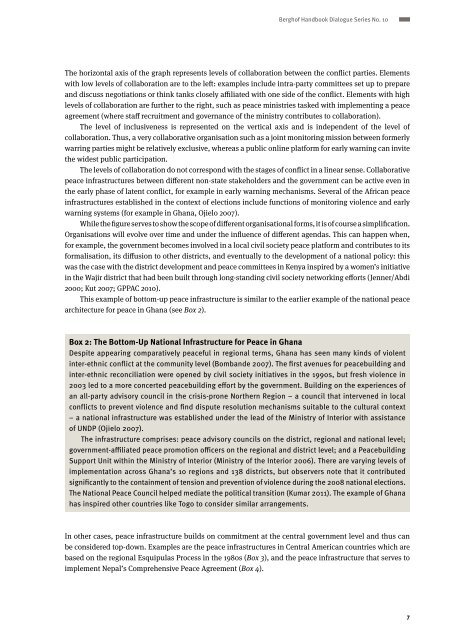Giving Peace an Address? - Berghof Handbook for Conflict ...
Giving Peace an Address? - Berghof Handbook for Conflict ...
Giving Peace an Address? - Berghof Handbook for Conflict ...
You also want an ePaper? Increase the reach of your titles
YUMPU automatically turns print PDFs into web optimized ePapers that Google loves.
<strong>Berghof</strong> H<strong>an</strong>dbook Dialogue Series No. 10<br />
The horizontal axis of the graph represents levels of collaboration between the conflict parties. Elements<br />
with low levels of collaboration are to the left: examples include intra-party committees set up to prepare<br />
<strong>an</strong>d discuss negotiations or think t<strong>an</strong>ks closely affiliated with one side of the conflict. Elements with high<br />
levels of collaboration are further to the right, such as peace ministries tasked with implementing a peace<br />
agreement (where staff recruitment <strong>an</strong>d govern<strong>an</strong>ce of the ministry contributes to collaboration).<br />
The level of inclusiveness is represented on the vertical axis <strong>an</strong>d is independent of the level of<br />
collaboration. Thus, a very collaborative org<strong>an</strong>isation such as a joint monitoring mission between <strong>for</strong>merly<br />
warring parties might be relatively exclusive, whereas a public online plat<strong>for</strong>m <strong>for</strong> early warning c<strong>an</strong> invite<br />
the widest public participation.<br />
The levels of collaboration do not correspond with the stages of conflict in a linear sense. Collaborative<br />
peace infrastructures between different non-state stakeholders <strong>an</strong>d the government c<strong>an</strong> be active even in<br />
the early phase of latent conflict, <strong>for</strong> example in early warning mech<strong>an</strong>isms. Several of the Afric<strong>an</strong> peace<br />
infrastructures established in the context of elections include functions of monitoring violence <strong>an</strong>d early<br />
warning systems (<strong>for</strong> example in Gh<strong>an</strong>a, Ojielo 2007).<br />
While the figure serves to show the scope of different org<strong>an</strong>isational <strong>for</strong>ms, it is of course a simplification.<br />
Org<strong>an</strong>isations will evolve over time <strong>an</strong>d under the influence of different agendas. This c<strong>an</strong> happen when,<br />
<strong>for</strong> example, the government becomes involved in a local civil society peace plat<strong>for</strong>m <strong>an</strong>d contributes to its<br />
<strong>for</strong>malisation, its diffusion to other districts, <strong>an</strong>d eventually to the development of a national policy: this<br />
was the case with the district development <strong>an</strong>d peace committees in Kenya inspired by a women’s initiative<br />
in the Wajir district that had been built through long-st<strong>an</strong>ding civil society networking ef<strong>for</strong>ts (Jenner/Abdi<br />
2000; Kut 2007; GPPAC 2010).<br />
This example of bottom-up peace infrastructure is similar to the earlier example of the national peace<br />
architecture <strong>for</strong> peace in Gh<strong>an</strong>a (see Box 2).<br />
Box 2: The Bottom-Up National Infrastructure <strong>for</strong> <strong>Peace</strong> in Gh<strong>an</strong>a<br />
Despite appearing comparatively peaceful in regional terms, Gh<strong>an</strong>a has seen m<strong>an</strong>y kinds of violent<br />
inter-ethnic conflict at the community level (Bomb<strong>an</strong>de 2007). The first avenues <strong>for</strong> peacebuilding <strong>an</strong>d<br />
inter-ethnic reconciliation were opened by civil society initiatives in the 1990s, but fresh violence in<br />
2003 led to a more concerted peacebuilding ef<strong>for</strong>t by the government. Building on the experiences of<br />
<strong>an</strong> all-party advisory council in the crisis-prone Northern Region – a council that intervened in local<br />
conflicts to prevent violence <strong>an</strong>d find dispute resolution mech<strong>an</strong>isms suitable to the cultural context<br />
– a national infrastructure was established under the lead of the Ministry of Interior with assist<strong>an</strong>ce<br />
of UNDP (Ojielo 2007).<br />
The infrastructure comprises: peace advisory councils on the district, regional <strong>an</strong>d national level;<br />
government-affiliated peace promotion officers on the regional <strong>an</strong>d district level; <strong>an</strong>d a <strong>Peace</strong>building<br />
Support Unit within the Ministry of Interior (Ministry of the Interior 2006). There are varying levels of<br />
implementation across Gh<strong>an</strong>a’s 10 regions <strong>an</strong>d 138 districts, but observers note that it contributed<br />
signific<strong>an</strong>tly to the containment of tension <strong>an</strong>d prevention of violence during the 2008 national elections.<br />
The National <strong>Peace</strong> Council helped mediate the political tr<strong>an</strong>sition (Kumar 2011). The example of Gh<strong>an</strong>a<br />
has inspired other countries like Togo to consider similar arr<strong>an</strong>gements.<br />
In other cases, peace infrastructure builds on commitment at the central government level <strong>an</strong>d thus c<strong>an</strong><br />
be considered top-down. Examples are the peace infrastructures in Central Americ<strong>an</strong> countries which are<br />
based on the regional Esquipulas Process in the 1980s (Box 3), <strong>an</strong>d the peace infrastructure that serves to<br />
implement Nepal’s Comprehensive <strong>Peace</strong> Agreement (Box 4).<br />
7
















